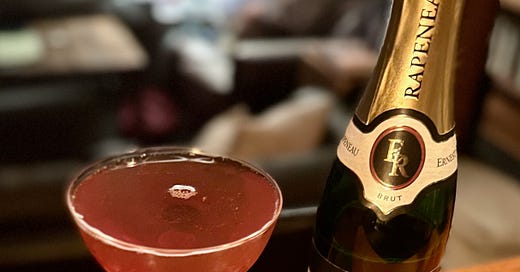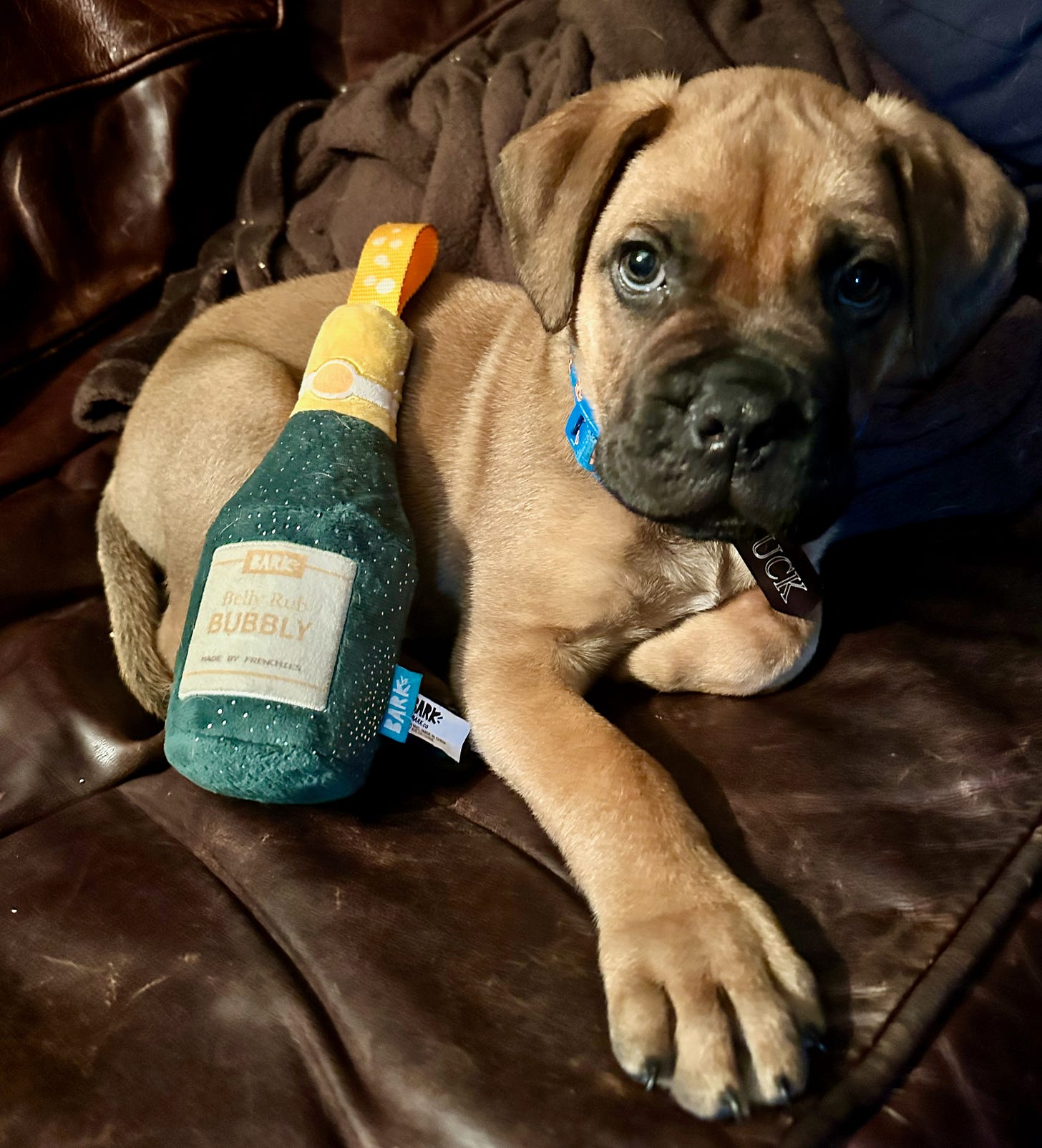For New Year’s, Top Your Manhattan With Champagne
A subtle, sparkly twist on a stirred-and-boozy classic.
If you’re reading this newsletter, that probably means you like cocktails—and, even more so, it probably means you have a fondness for stirred-and-boozy drinks, at least when it’s cold, and maybe when it’s not.
On New Year’s Eve, it’s usually cold. But tradition dictates that you should drink Champagne, or something similarly light and bubbly. So what are you going to do?
There are, of course, a handful of well-known Champagne cocktails: The French 75, essentially a gin sour topped with sparkling wine, is probably the most famous, with the Champagne cocktail, which merely adds bitters and sugar to the mix, turning into a bubbly Old Fashioned, running close behind.
But this year, let me recommend a wintry, stirred-and-boozy classic—the Manhattan—topped with just a bit of Champagne.
This gives you a cocktail called the Boothby.
This is different than the Alfonso, the Champagne-based cocktail that uses Champagne as the base of a Manhattan-esque concoction. This one really is just a Manhattan…but with Champagne.
It’s a lesser-known entry in the cocktail canon, but it’s a favorite of drinks writer and fellow Substacker Robert Simonson. Simonson has written about it on multiple occasions, and has put it on cocktail menus at various events. I’m not sure whether I first heard about the Boothby from him, but he is responsible for keeping the drink at the top of my mind.
I’ll be honest, I was somewhat skeptical when I first looked over the recipe: I’m not always a huge fan of Champagne-topped cocktails. Conceptually, it seemed especially strange to take a drink as excellent and elemental as the Manhattan and top it with Champagne. Taking a gin sour and expanding it with Champagne into a French 75? Sure. A French 75 is a sort of boozy lemonade soda, with Champagne for the carbonation. But a sparkling Manhattan? Even if it tasted okay, why not just make a Manhattan? How could the addition of Champagne improve an already perfect drink?
Yet as sometimes happens with new friends after a New Year’s Eve together, I’ve come around to the Boothby’s charms.
It’s not so much that Champagne improves the Manhattan as that it provides a seasonally appropriate twist, a lightness and dryness that gives this otherwise brooding, moody cocktail a little pep. The Boothby is a party-ready Manhattan with a skip in its step and a twinkle in its eye, perfect for ringing in the New Year.
There are, however, better ways to make a Boothby, including selecting the right ingredients and getting the proportions right. It also helps to understand the drink’s structural properties and similarities to other drinks.
After all, New Year’s is often understood as a time for self-reflection and reinvention: You can make a better version of yourself if you have a better understanding of who you really are.
The same goes for cocktails like the Boothby.
Minstrel, Tailor, Realtor, Barman
The Boothby cocktail is named for William T. “Cocktail Bill” Boothby, a pre-Prohibition multi-hyphenate who lived, drank, wrote, and mixed liquors in the San Francisco area during the late 1800s and early 1900s.
The first line of John C. Burton’s entry on Boothby (the man) in The Oxford Companion to Spirits & Cocktails casts him as a “minstrel, tailor, realtor, streetcar conductor, [and] San Francisco assemblyman,” which, if nothing else, sounds like a strange spinoff of a John le Carre novel.
Boothby was nonetheless known first and foremost for his cocktails, and several books about them.
The first of those books, Cocktail Boothby's American Bar-Tender, is all but lost, with only two known original copies remaining, although you can purchase a reprint. In later years, he also authored another volume of drink recipes, The World's Drinks and How to Mix Them, which you can also buy in a reprint edition.
Boothby was something of a character: He fell into the bartending trade mostly by accident, then started keeping notes on the drinks he was making and his various methods. This led to the publication of his books. (Taking notes, it turns out, is useful.)
Those notes included recipes. But his first book also included a section on “Valuable Secrets for Liquor Dealers,” including methods for faking the aging of liquor by, say, adding prune juice to booze barrels. Perhaps unsurprisingly, in 1922 he was arrested for serving alcohol during Prohibition.
Manhattan Transfer
The drink named after him is also a bit devilish. Adding dry Champagne to a Manhattan gives it a bit of lift and zest, a bit of personality that you won’t find in the classic version of the drink. I’ve come to think of it as a sort of Manhattan Surprise.
The Surprise is that it still tastes a lot like a Manhattan, so long as you keep the Champagne in check. The trick with this drink is to hold the Champagne at just a single ounce. This isn’t a long drink, like a Tom Collins, so much as a short drink wearing a sparkly hat.
That single ounce of dry, zesty Champagne turns this into something like a 50/50 Perfect Manhattan, with a bit of sparkle.
To understand what I mean, it helps to look at the original Manhattan, the 50/50 Manhattan, and the Perfect Manhattan, and see how this drink combines elements of all three.
A typical Manhattan combines about two ounces of whiskey (usually rye) with one ounce of sweet vermouth, plus bitters, making for a 2:1 ratio.
2 dashes bitters
1 ounce sweet vermouth
2 ounces whiskey
A 50/50 Manhattan adjusts the rye:vermouth ratio to 1:1, equal parts, like so:
2 dashes bitters
1 ½ ounces sweet vermouth
1 ½ ounces whiskey
And then there’s the Perfect Manhattan, which, whatever the ratio, uses both sweet vermouth and dry vermouth. In the standard 2:1 whiskey:vermouth ratio, that looks like this:
2 dashes bitters
½ ounce dry vermouth
½ ounce sweet vermouth
2 ounces whiskey
The Boothby isn’t typically described as a form of Perfect Manhattan. But if you add one ounce of dry Champagne to a standard 2:1 Manhattan, you end up with a drink where the proportions look like this:
Bitters
1 ounce dry Champagne
1 ounce sweet vermouth
2 ounces whiskey
Yes, this is a four-ounce drink (excluding bitters), rather than the traditional three-ounce portion for a Manhattan. And yes, Champagne is not vermouth. But like vermouth, it’s a form of wine. And it’s dry and light.
So now you have equal parts wine and whiskey, like a 50/50. And the wine portion is split between a sweet wine and a dry wine—just like a Perfect Manhattan. Thus, it resembles a 50/50 Perfect Manhattan.
In the glass, it balances much the same way, with the Champagne slightly drying out the mix. This why it’s important to make sure that you don’t simply “top with Champagne” and then pour some random amount between 1-4 ounces depending on your glass size.
That single ounce gives the drink a classic, familiar balance, as well, of course, as the bubbly zest of Champagne.
Rye Are We Even Here?
To complement that Champagne, I recommend a lighter rye whiskey and a lighter vermouth.
My go-to, everyday Manhattan pairing is Rittenhouse rye and Carpano Antica Formula sweet vermouth. Both are big, burly spirits with robust presences.
Although this drink will certainly work with that pair, I found it works better with Old Overholt rye, which is fruitier and lower ABV than Rittenhouse, plus Dolin Rouge vermouth, which is more delicate than Carpano Antica. This is a drink with a dancer’s grace, not a strong man’s weight.
The lightness, however, means that the amount and choice of bitters will make a big difference. Some recipes call for two dashes of Angostura, some for two dashes of orange bitters, some for a dash of each. But I had the best luck with two dashes of each, which grounds the mix and adds complexity without weighing it down.
The sensitivity of this cocktail also makes it an excellent vehicle for bitters experimentation. Try peach bitters and mole bitters, for example, for a more dessert-like variation. Or use cinnamon bitters in combination with either Angostura or orange bitters for more holiday spice.
As for the Champagne, use something on the dry side, and don’t feel the need to spring for a pricey bottle unless you are a wine geek with strong opinions on the stuff—in which case I am sure you’re already planning your midnight cork popping and don’t need my advice.
Made well, the Boothby is a light and festive take on the Manhattan, a serious drink made just a little more fun and approachable—but not so much that it becomes unserious. It’s a great way to combine a stirred-and-boozy cocktail format with celebratory Champagne and ring in the New Year.
Boothby
2 dashes orange bitters, such as Regan’s
2 dashes Angostura Aromatic bitters
1 ounce sweet vermouth, preferably Dolin Rouge
2 ounces rye, preferably Old Overholt
1 ounce dry Champagne, to top
INSTRUCTIONS
Combine all ingredients except Champagne in a mixing glass.
Add ice, then stir briefly to chill and dilute. You don’t need to stir as long/dilute as much as a typical Manhattan since the Champagne will help bring down the ABV.
Strain into a coupe or Nick & Nora glass.
Top with one ounce of Champagne.
Garnish with a Luxardo maraschino cherry.
Happy New Year’s!
Lil Cuz Has Already Broken Out the Bubbly
Happy New Year from Huckleberry!






how close does prosecco get to being apropos? is this a Boothby faux pas?
What’s at hand: Woodford Rye / Carpano Sweet / Angostura / LaMarca.
Don't be mad at me. I guess I had this drink in mind when I went to make a cocktail last night. My kids had some leftover watermelon from dinner, so I was thinking about what would work with some watermelon juice. First thing I thought of was sweet vermouth, then realized dry vermouth would also play. So I of course made a perfect Manhattan with an ounce of watermelon juice added. It was fine.